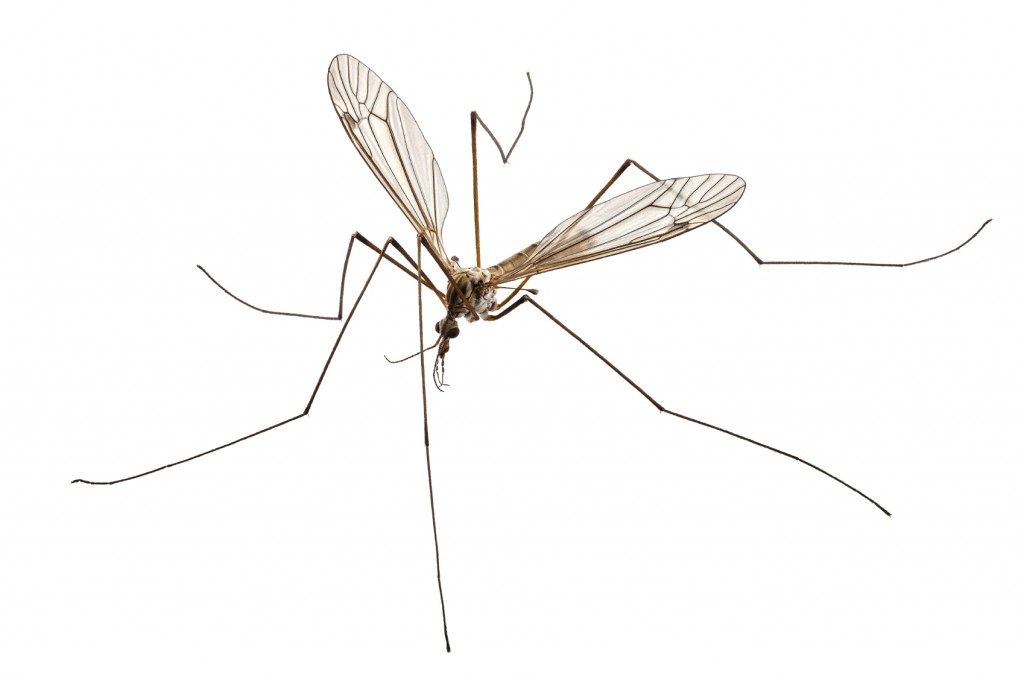Crane Flies not a Mosquito – Canton Termite and Pest Control
Crane flies are some of the more greatly misunderstood insects around. Appearing to most people as gigantic mosquitoes, they are quite often falsely accused of biting and performing Dracula-esque actions on humans and pets. The crane fly doesn’t even have the body parts required to bite anything like a human or pet, so, though confusing in appearance, they certainly cannot suck your blood! The American Mosquito Control Association has this to say about crane flies:
“Crane Flies (Tipulidae) are delicate insects varying in size from ¼ inch to as large as 1½ inches in length. The largest crane flies are sometimes called ‘daddy-long-legs’, ‘gully nippers’, or “mosquito hawks”. However, they do not bite people and they do not eat mosquitoes. Some species of crane flies emerge from aquatic sources and others from terrestrial or decaying vegetation sources. Crane flies are not predacious and usually many times larger than a typical mosquito. Adults are strongly attracted to porch lights. The larvae live in loose soil or organic matter and feed on the roots of plants.”
These insects are also called Mosquito Hawks, a name to which they have no claim whatsoever. The crane fly cannot, again, bite much of anything because of the way they are made, and so as a result, they are not predatory at all. What then do crane flies actually eat? Well, they mostly eat decaying plant matter, but not much! You see, crane flies only live in the adult stage you see flying around for a period of a few days, so they do not actually need to eat very much at all. Crane flies spend most of their lives in the larval stage, which has quite a large number of morphologies. This means, essentially, that they all can look different and be capable of performing different survival techniques through mechanisms they have been provided with to survive. There are more than 15,000 different species of crane flies! Here are some awesome examples of the different ways that the larvae of crane flies may appear under the soil of your yard, provided by Matthew Bertone, PhD:
“Some of them have inflatable rear ends that they use to move through soil more easily, some have fringed setae on the end to break the water tension, and some have these weird creeping structures, sort of like caterpillar prolegs with hooks on them, so it’s extremely variable. We don’t know much about the larvae. In fact, for many species, we have never seen the larvae… Most of the {adult} crane flies have big eyes, but we don’t know how good their vision is and how much that’s used to sense where they’re going. The males in some of the groups have antennae with really elongate segments compared to females, but we don’t know what the purpose of that is.”
As far as the adult form of the crane fly, Bertone has this to say:
“I’m always seeing photos of new ones, and it just blows my mind how they look or how they have all these crazy modifications. There are strange, wingless, spider-like snow crane flies that are thought to live in animal burrows and crawl underneath the snow; there are small, hairy ones; there are larger ones; there are lots of them that suck nectar — it’s a really diverse and pretty amazing group.”
This means there is incredible variety in development among the species, but I digress. Let me speak for a moment regarding the aspects of crane flies that affect your home, yard, and family.
Crane flies cause no harm to other creatures. This means that, although they look like super-sized mosquitoes, they are just harmless bugs that fly around and bother you sometimes; however, crane flies have been known to damage some kinds of turf in yards by feeding on the roots. UCIPM, a statewide integrated pest management program in California, has done some research on the damage to turf that crane flies can cause, and what to do about it:
“Affected turf appears as dying patches. Feeding damage may be apparent on roots, crowns,and aboveground portions of grass plants. Weeds may invade areas of dying turfgrass. Adults do not damage grass or feed at all. Although sometimes called ‘mosquito hawks, crane flies do not feed on mosquitoes or other insects or harm people… Turf can easily recover from crane fly feeding if properly maintained. Follow recommended irrigation and fertilization practices for your turf species. Crane flies are often associated with wet or waterlogged areas. Remove excess thatch and aerate to stimulate root growth and improve water and nutrient movement into the soil. Reduce shady areas by pruning back tree branches to allow more light to reach the turf during the early morning and late afternoon. Beneficial nematodes may help reduce high populations.”
If you have a question about what crane flies might be doing you your yard, call us here at Canton Termite and Pest Control Today at 770-479-1598! For more information on crane flies, the articles below should be helpful. These articles and their sources were used to help write this blog post! Thanks for reading, and if you have any questions, please do not hesitate to contact us through Canton Termite and Pest Control’s website, email, or by phone.
